This sleepy hamlet, located in a
bowel-shaped Valley, lies 12
kms to the east of the historic
Shiva temple of Baijnath in
Palampur, Himachal Pradesh.
Visiting Rainabari was fulfilling
a dream conceived ten years
ago. In 1996, the correspondent
of the
Daily Tribune
had
published a small news item
about Rainabari. He had tried
to link up 14th September, the
day observed every year by
the Displaced Kashmiri Hindus
as 'Martyrs' Day since
1990, with the saga of Rainas
of Rainabari, whose forefathers
had left Kashmir in virtually
similar circumstances
four centuries ago. Another
attraction for visiting
Rainabari was that these
Rainas originally hailed from
Rainawari quarter of
Srinagar, the place which
once used to be my sweet
home. We had also information
that Suresh Raina, the
promising test cricketer, too
hailed from Rainabari.
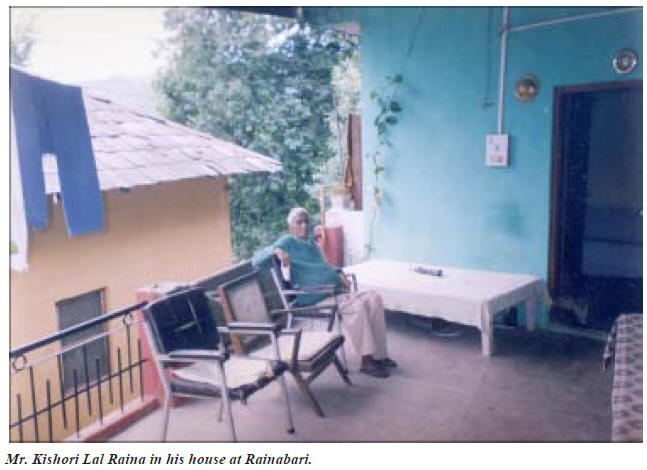
Back home in Kashmir, I
used to be haunted by a curiosity-
where had the Rainas of
Rainawari gone? Not only all
the Rainas of Kashmir belonged
to Rainawari, even the
quarter was named after this
clan - 'Rajanvatika' (the place
where Rainas live). In my time
only few Rainas lived in
Rainawari, though more than
1500 Pandit families lived there.
It was presumed that either
Rainas might have moved to
other parts of Srinagar and Kashmir
as part of routine social mobility,
or else many Rainas had
adopted new 'Krams'. This is a
matter for investigation.
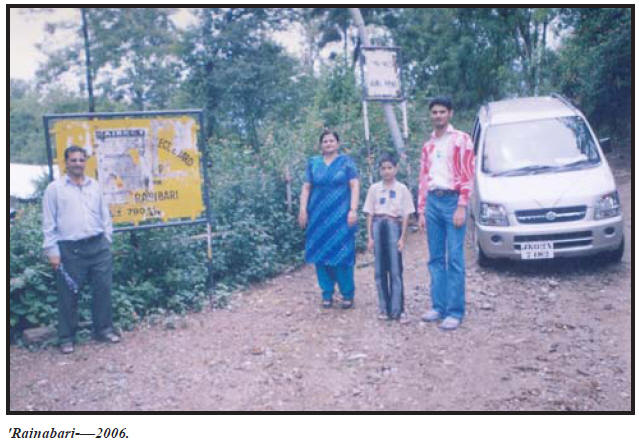
After 1990 part of our curiosity
was satisfied when we
learnt that many families, including
Sikhs in Jammu, Budhal,
Sunderbani, Billawar, Poonch,
district Kangra carried Raina
surnames and believed themselves
to be originally
Kashmiris. It can be safely stated
that Rainas were the largest
group among Kashmiri Hindus,
who moved out of Kashmir during
the past few centuries to
Jammu region and Himachal
Pradesh. In what circumstances
these Raina families left Kashmir
it needs a comprehensive
investigation. This author in an
earlier article had traced some
traditions common to Rainas of
Jammu region and Bilaloch
Brahmins of northern India.
While in Palampur, a heavy
downpour on a Sunday morning
virtually sealed off our visit to
Rainabari. However, we were
determined to take our chance.
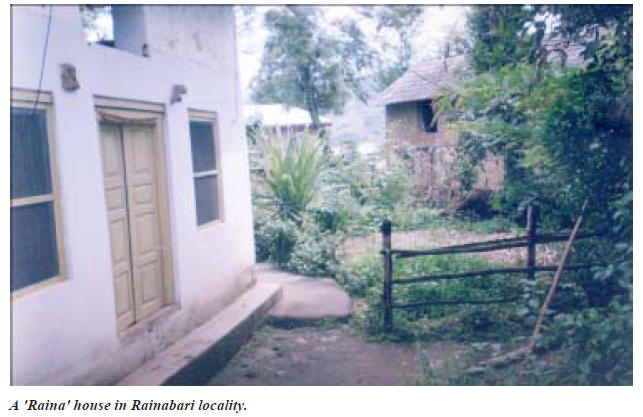
To our surprise, when we
reached Baijnath, the rains
stopped and the sun slowly made
its appearance. We also traced
Baijnath's Kashmir links. There
are more than ten Sarda inscriptions,
including two granite
slabs, in the main temple. There
is also a tradition, that a
Kashmiri - Ram Kavi was the
calligrapher of these inscriptions.
In Baijnath town, people felt
amused when we informed them
that our destination was
Rainabari. This place was neither
a tourist spot nor housed any
religious shrine. They asked us
if we had any relations in the village.
We told them our relation
with Rainas of Rainabari were
for deeper and rooted in history
the village derived its name from
our home place.
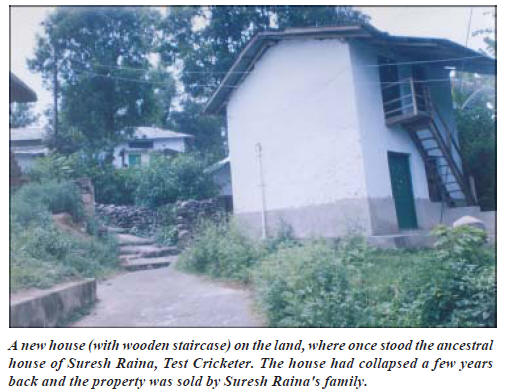
An hour's journey along a narrow
circuitous road took us to
Rainabari. We had the impression
that Rainabari village with
dense foliage all around it,
housed only few Raina families
which lived among other
Himachali families. As we entered
the village, our next task
was to locate if any Raina family
lived in the village. Fortunately,
the very first person - a
young man, who had spent sometime
in Kashmir doing his B-ed,
turned out to be a Raina. We
gave our brief but quite pertinent
introduction - "We hail from Rainawari in Kashmir and
wanted to see our biradari people
who had left that place to settle
down in Rainabari four centuries
ago". This had a telling effect -
that we were on a mission to
trace our missing links.
This gentlemen led us into his
house. Soon, the head of the family,
Sh. Kishori Lal Raina came
out to receive us. His warm hospitality
and affectionate welcome
put us at ease. He felt quite
happy on learning that we belonged
to Rainawari in Kashmir.
Sh. Kishori Lal Raina had served
Himachal Pradesh Information
Department and retired as District
Public Relations officer. He
spoke English fluently and took
great pride in his Kashmiri ancestry.
It was our good luck that
we were able to contact the right
person. Despite his failing
health, he was quite enthusiastic
to share his information with us.
Before we could beging serious
conversation, my son Achin
had his own query to satisfy.
Speaking out of turn, he asked
Kishori Lal Ji whether it was true
that Test Cricketer Suresh Raina
hailed from this village. Kishori
Lal Ji informed that Suresh
Raina's grandfather Satyarthi
Raina and he were first cousins.
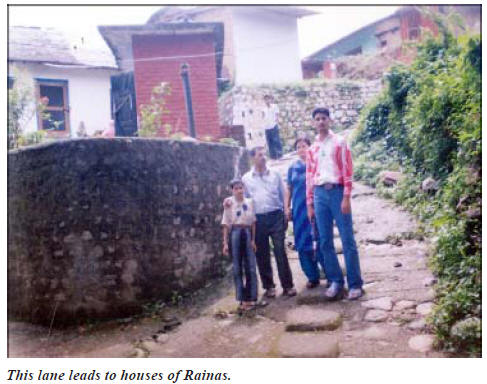
Satyarthi's father, Chandu Lal
Raina, who retired as Captain, in
the army was elder brother of
Kishori Lalji's father, Sh.
Khazana Ram Raina. Gasita
Ram Raina had two sons - Chandu Lal Raina and Khazana
Ram Raina. Sometime back, Sh.
Satyarthi Raina had migrated to
Baraeilly. He had sought voluntary
retirement from Indian Navy
and later rejoined as an engineer
in some private firm. Satyarthi
Raina was married to Smt.
Santosh. Mr Kishori Lal Raina
had another link with Suresh
Raina's family. Suresh's grandmother
(Nani) was aunt (Mossy)
of Sh. Kishori Lal. Suresh's
grandfather (Nana), Bipin
Chander Pal was a non-Kashmir.
He was Manager of a transport
company and died young in a
road traffic accident.
According to Kishori Lal,
forefathers of Rainas of
Rainabari had migrated from
Kashmiri during the persecution
period of Emperor Aurangzeb.
Rainas' ancestor, who migrated
from Kashmir was Gadhru
Raina. While leaving Kashmir,
they had carried along their
Kuldevi in a palanquin. They
rested at a place on the bank
of river Jhelum. All of a sudden
the Kuldevi disappeared.
Then the Raina family put
Bred (a thorny bush) into the
palanquin and brought it with
them. In marriages the first
ritual begins with puja of this
400 year old bred. Gotra of
these Rainas is Gautam. This
again corroborates their
Kashmiri origin. Initially,
these Rainas had settled at
Haripur (Guler) in District
Kangra. They were
Kulpurohits of Raja of
Haripur. This King had also
bestowed his munificence on
the family of another Kashmiri
Pandit, Seu Raina, believed to
be the originator of Pahari
school of Art. It is yet to ascertained
whether the families
of Pt. Gadhru Raina and Pt.
Seu Raina belonged to the same
clan. Gadhru Raina's family
earned name and fame for
practicising
Jyotish Vidya.
A
legendary account claims that
they could make fish fly, bring it
to life again after roasting it in
fire. No details are available
about the circumstances in which
Gadhru Raina's family shifted
from Haripur Guler to Rainabari.
Maintaining cultural ethnic
identity in alien circumstances
poses a formidable challenge.
Sh. Kishori Lal Ji, a man of deep
integrity, was quite candid in explaining
how over a period of
time they lost their Kashmiri traditions.
He said their ancestors
always remained strongly nostalgic
about their Kashmiri origin,
Mr. Kishori Lal Raina in his house at Rainabari.
and traditions of Kashmiri Pandits. They continued to transmit,
whatever they knew about their Kashmiri origin and circumstances
of migration to succeeding generations. Some of
the Kashmiri customs were discarded as these conflicted with
those of Himachali Hindus. For example, on the occasion of
death Kashmiri Pandits blow conchshells. This is considered
inauspicious by Himachalis because conchshells are blown
on marriages also. Had these Rainas persisted with these
traditions,
they could have faced social ostracisation. Mundan
hair of Rainas are deposited in the Balak Ropi temple,
Alampur - 45 kms away from Palampur. Rainas of Rainabari
continue to relish Dam Alu, Saag etc. Since no good quality
meat as available in Palampur-Baijnath area, Rainabari Rainas
have no knowledge about Kashmiri non-vegetarian cuisine.
They, however, relish chicken.
Due to lack of opportunities - education and economic, Rainas of Rainabari are gradually abandoning the place where
they have lived for more than three centuries. Presently, there
are only 14 houses of Rainas in Rainabari. There are no non-
Raina families here. Some have moved to Baijnath, Palampor,
Lambagaon Panchkula, Jawalamukhi, Chamba etc. Satish
Raina runs Jagan Restaurant in Chamba. One of the Raina
family, which continues to maintain its link with Rainabari,
lives in Gandhi Nagar, Jammu. This family has excelled in
education and includes a doctor, a bank official and a lecturer.
Suresh Raina's ancestral house had collapsed few years
back and a small new house has come up on that land.
Distinguished Rainas of Rainabari include Sh. Kishori Lal,
Sh Hira Lal Raina, Treasury officer, Sh. Nand Lal Raina,
Retd. Supdt. Civil Sectt., HP and late Prof. D.R. Raina. The
latter, a renowned Professor had done his MSc. from Lahore
University in 1932 and was a gold medalist. Prof. Raina also
rendered his services in NCC and was a captain there. Mr.
Kishori Lal's son is a Gold Medalist in MSc. Botany. He
teaches in a private school. Mr. Kishori Lal fondly recalled
his days with Sh. PK Mattoo, IAS (Retd.), also a Rainawarian.
He worked under Sh. Mattoo when the latter was Deputy
Commissioner in HP and had very high regard for his integrity
and helpful attitude. The latter also served as Chairman HPPSc and Chief Secretary, Himachal Government.
